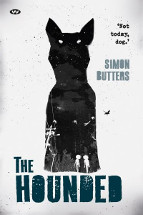The hounded by Simon Butters

Wakefield Press, 2016. ISBN 9781743053959
(Age: 16+) The black dog is a common metaphor for depression and in
the initial stages of this novel, the appearance of one to teenaged
Monty seems to indicate exactly that. Monty has an eating disorder,
is underweight and has an unnatural lack of appetite for food. His
personal hygiene has declined to the extent that he rarely washes,
smells and looks dirty as he dons the same filthy clothes day after
day.
Home life for this teenager is grim as his mother has a severe
psychiatric illness and endlessly chain smokes, confined to an
extremely dilapidated house which she believes is being entered by
persons unknown who steal its contents. Monty's father, obviously
trying to escape the pressure of the dysfunctional household seeks
refuge in his work and has little interaction with his son who is
clearly suffering from neglect in a home which fails his basic,
everyday needs and gives little structure to his life.
It is no surprise that visions of a black dog might be interpreted
as depression, however in this novel the creature develops to
represent something even more sinister and dangerous. Without giving
the plot away, there are many elements of teen trauma in this novel
(perhaps too many) and the reader is never quite sure if Monty's
conversations with the dog convey thoughts which he is working
through or whether he really is having delusional interactions with
a talking dog.
Where school should provide some refuge of normality and routine,
Monty is largely invisible except when being attacked by violent
thugs, cyber bullied or tormented by popular students who manipulate
and determine social acceptance versus pariah status. When Monty is
noticed by Eliza, the most beautiful and popular girl in school, he
is naturally overwhelmed by her attention and finds himself in
places and situations which are unfamiliar and challenging to him.
There are some really unappealing behaviours and traumatic
experiences on display in this novel. Luckily this is balanced to
some degree by kindness, decency and aspects of recovery.
The inclusion of so many traumas and miserable elements made this
story too 'busy' in my view, yet some might argue that it is a sad
but realistic portrayal of life for some teenagers. My stance may be
old fashioned and naive, however I have concerns that novels with
elements as bleak as this has can emphasise a sense of hopelessness
with young people, especially if they are in an emotionally
vulnerable state.
This is an edgy and different story in which the author has worked
hard and with success to describe scenes in which the reader can see
the dirt and share the pain. It will appeal to many adolescent
readers and I caution school staff to give thought regarding those
for whom it is appropriate to read for study or pleasure.
Rob Welsh